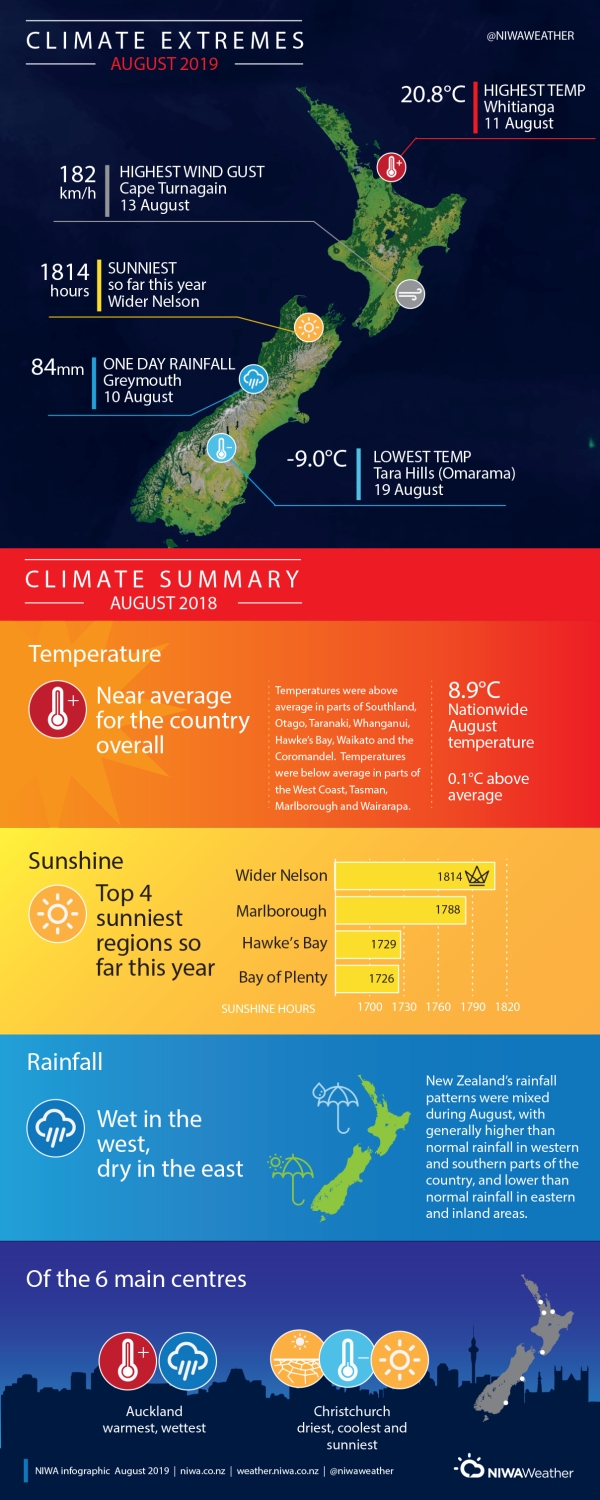Variable temperature and rainfall patterns with frequent southwesterly winds
|
Temperature |
Temperatures were above average (0.51°C to 1.2°C above average) in parts of central Southland, north Otago, Taranaki, Whanganui, southern Hawke’s Bay, Waikato and the Coromandel. Temperatures were below average (0.51°C to 1.2°C below average) in parts of the West Coast, Tasman, Marlborough and Wairarapa. |
|
Rainfall |
Rainfall was above (120% to 149% of normal) or well above normal (>149% of normal) for western and southern parts of the South Island, as well as coastal North Otago, Manawatu-Whanganui, central Waikato and Auckland. Rainfall was below (50% to 79% of normal) or well below normal (<50% of normal) in parts of western Otago, the Mackenzie Basin, eastern Canterbury, Hawke’s Bay, Gisborne, Bay of Plenty and eastern Northland. |
|
Soil Moisture |
As of 31 August, soil moisture was near normal for most of New Zealand. Soils were drier than normal for isolated parts of inland north Otago, and wetter than normal about Kaikoura. |
Overview
August 2019 was characterised by considerably lower than normal mean sea level pressure over and to the south of New Zealand. This set up resulted in a strong southwest airflow anomaly (i.e. more southwesterly winds) than normal across the country. The prevailing southwest winds delivered an unsettled month of weather to exposed southern and western parts of the country, with frequent periods of rainfall there. Several strong cold fronts were associated with these southwesterly winds, bringing periods of thunderstorms and even snowfall to sea level in parts of the West Coast (see Highlights and extreme events section for further details). The active climate pattern was fuelled by the polar and sub-tropical jet streams, which were stronger than normal in the New Zealand region. The weather was typically more settled in eastern and inland parts of the country which are relatively sheltered from southwesterly winds.
It has now been 31 consecutive months since New Zealand experienced a nationwide average temperature that was below average (at least 0.51˚C below the 1981-2010 average). The nationwide average temperature in August 2019 was 8.9°C (0.1°C above the 1981-2010 August average from NIWA’s seven station temperature series which begins in 1909). Temperatures were above average (0.51°C to 1.2°C above average) in parts of central Southland, north Otago, Taranaki, Whanganui, southern Hawke’s Bay, Waikato and the Coromandel. Isolated areas observed well above average temperatures (>1.2°C above average) including Middlemarch and Hastings. In contrast, temperatures were below average (0.51°C to 1.2°C below average) in parts of the West Coast, Tasman, Marlborough and Wairarapa. Temperatures were typically near average (within 0.50°C of average) for remaining areas of the country.
Rainfall was variable throughout New Zealand. Eastern and inland parts of the country were generally drier than normal. Specifically, rainfall was below (50% to 79% of normal) or well below normal (<50% of normal) in parts of western Otago, the Mackenzie Basin, eastern Canterbury, Hawke’s Bay, Gisborne, Bay of Plenty and eastern Northland. In contrast, many western and southern parts of the country observed a wetter than normal August. Rainfall was above (120% to 149% of normal) or well above normal (>149% of normal) for parts of Southland, the West Coast, coastal North Otago, Manawatu-Whanganui, central Waikato, Auckland and the Far North.
Further Highlights:
- The highest temperature was 20.8°C, observed at Whitianga on 11 August.
- The lowest temperature was -9.0°C, observed at Tara Hills (Omarama) on 19 August.
- The highest 1-day rainfall was 84 mm, recorded at Greymouth on 10 August.
- The highest wind gust was 182 km/h, observed at Cape Turnagain on 13 August.
- Of the six main centres in August 2019, Auckland was the warmest and wettest, while Christchurch was the coldest, driest and sunniest.
- Of the available,regularly reporting sunshine observation sites, the sunniest four regions in 2019 so far are Wider Nelson (1814 hours), Marlborough (1788 hours), Hawke’s Bay (1729 hours), and Bay of Plenty (1726 hours).
Download
New Zealand Climate Summary August 2019 [PDF 364KB]
New Zealand climate statistics August 2019 [PDF 66KB]


